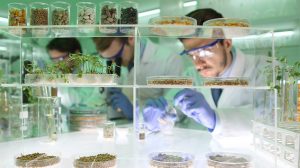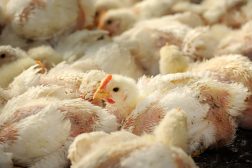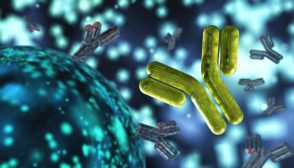Table of Contents
Definition
noun
plural: trehaloses
tre·ha·lose, loʊs
A disaccharide made up of two α-glucose molecules, and serves as an energy source in certain fungi, bacteria, plants, and invertebrates
Details
Overview
Carbohydrates are a major class of biomolecules that can be classified based on the saccharide constituents. A disaccharide is a carbohydrate made up of two monosaccharides that are linked together by a glycosidic bond (glycosidic linkage). Trehalose is an example of a disaccharide carbohydrate.
History and terminology
In 1832, H. A. L. Wiggers published in his paper about his discovery of trehalose in an ergot of rye. The name trehalose was coined by Marcellin Berthelot in 1859. He based it from where he was able to isolate the sugar – the trehala, a sugarlike edible substance from the pupal case of weevils.
Properties
Trehalose is a white crystalline disaccharide made up of two molecules of glucose joined by 1-1 α-glycosidic bond. Thus, it is also chemically referred to as α-D-glucopyranosyl-(1→1)-α-D-glucopyranoside. Similar to the common disaccharides (e.g. maltose and sucrose), it has a chemical formula of C12H22O11.
Trehalose is closely similar to maltose in terms of saccharide components (i.e. two glucose units). However, maltose has α-1→4 glycosidic bond as opposed to trehalose that has α-1→1 glycosidic bond. This means that in trehalose, the bond occurs between Carbon(C)-1 of glucose and C-1 of the other glucose. In maltose, the bond is between C-1 and C-4. A glycosidic bond of β-(1→4) between two glucose units forms cellobiose whereas α-(1→6) bond between two glucose units forms isomaltose. Unlike maltose, trehalose is a nonreducing sugar. The glycosidic bond that joins the two glucose units keeps trehalose in a closed-ring form. Consequently, the aldehyde or the ketone ends cannot bind with lysine or arginine of proteins. Thus, trehalose is resistant to acid hydrolysis. It is also for this reason that it is stable in acidic conditions or at high temperatures. The high water retention property of trehalose and serving as a source of energy help organisms survive during long periods of freezing or dry condition.
Common biological reactions
Common biological reactions
α,α-trehalose is the only anomer of trehalose naturally produced to be metabolized as an energy source by certain fungi, bacteria, plants, and invertebrates (e.g. shrimps and insects). They have the enzymes that enable them to produce trehalose biosynthetically. One of the most common metabolic pathways is through the enzymatic activity of trehalose-phosphate synthase. The glucose from UDP-glucose is transferred to glucose-6-phosphate to form threlaose-6-phosphate plus UDP via the action of trehalose-phosphate synthase. Then, another enzyme (trehalose-P phosphatase) catalyzes the dephosphorylation of trehaloses-phosphate (Elbein, 2003).
Common biological reactions
Trehalose is broken down into glucose units through the aid of the enzyme trehalase. In insects, trehalose is the major energy source for flight. The trehalase enzyme enables the conversion of trehalose into two glucose units, providing fast source of energy required during insect flight. In humans and other higher animals, the digestion of trehalose is aided by α-glucosidase trehalase. It is present in the brush border of the intestinal mucosa.
Biological importance
Trehalose is a natural disaccharide. It is naturally produced by organisms, such as bacteria, yeast, fungi (e.g. shiitake), invertebrates (e.g. shrimps), insects (e.g. bees, butterflies, grasshoppers, etc.), and plants. These organisms have the enzymes that enable them to biosynthesize trehalose (Elbein, 2003).
Trehalose is biologically essential as it serves as a source of energy and carbon. In certain insects, it is the major form of carbohydrate they use to derive energy for flight. It also serves as an important structural component of cell wall where it acts as an osmoprotector (Zentella et al., 1999). The resurrection plant, Selaginella, makes use of trehalose to fight against desiccation, heat, and dehydration. The trehalose helps it to grow in the desert and survive arid conditions. During dry condition, the plant rolls up into a brown ball, seemingly dead from drying out. But upon contact with water (e.g. from rain), it seems to resurrect by turning green again and resuming growth (thus, the name). This resurrection phenomenon is referred to as poikilohydry (Zentella et al., 1999). Trehalose has been found to protect cells of organisms from stressful conditions, such as heat, cold, dehydration, and oxidation (Elbein, 2003).
In herbivores and omnivores, including humans, trehalose can be derived from starchy food, mushrooms, and shellfish. Dietary trehalose is broken down by the action of the enzyme trehalase. The enzyme cleaves the glycosidic bond and thereby helps release two glucose molecules. Synthetic trehalose is used in the manufacture of cosmetics, food, and drugs. It is an important ingredient in frozen foods (e.g. ice cream) as it can depress the freezing point of food. It is less sweet than sucrose and does not cause spike in blood sugar as some sugars would (Collins, 2018). However, too much consumption of trehalose is also not advised as studies found that it promoted the growth of the natural gut bacterium Clostridium difficile. Futhermore, the toxins from trehalose metabolism also increased (Collins, 2018).
Inborn error of metabolism
The deficiency of trehalase is considered as a rare metabolic condition in humans. Trehalase deficiency is characterized by the lack or insufficiency of the enzyme trehalase. Without a sufficient functional trehalase, the disaccharide trehalose is not readily digested and metabolized, and therefore accumulates. The affected individual experiences abdominal discomfort and diarrhea when eating trehalose-laden food. The genetic cause of trehalase deficiency is a mutation in the TREH gene.
Supplementary
Etymology
- New Latin trehāla, from Turkish tıgala, (a kind of “manna”)
IUPAC
Chemical formula
- C12H22O11
Synonym(s)
Further reading
See also
- carbohydrate
- disaccharide
- glucose
Mentions
Reference
- Collins, F. (2018, January 16). Has an Alternative to Table Sugar Contributed to the C. Diff. Epidemic? Retrieved from ://directorsblog.nih.gov/2018/01/09/has-a-sucrose-alternative-contributed-to-the-c-diff-epidemic/ Link
- Elbein, A. D. (2003). New insights on trehalose: a multifunctional molecule. Glycobiology, 13(4), 17R–27. ://doi.org/10.1093/glycob/cwg047 Link
- Zentella, R., Mascorro-Gallardo, J. O., Van Dijck, P., Folch-Mallol, J., Bonini, B., Van Vaeck, C., … Iturriaga, G. (1999). A Selaginella lepidophylla trehalose-6-phosphate synthase complements growth and stress-tolerance defects in a yeast tps1 mutant. Plant Physiology, 119(4), 1473–82. Retrieved from ://www.ncbi.nlm.nih.gov/pmc/articles/PMC32033/ Link
© Biology Online. Content provided and moderated by Biology Online Editors







